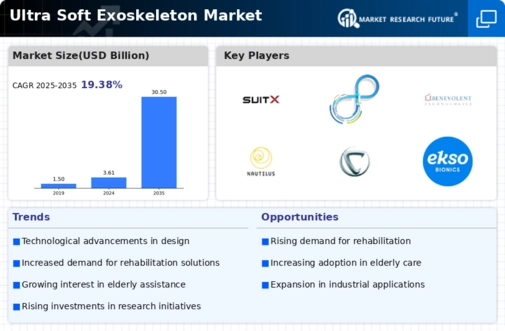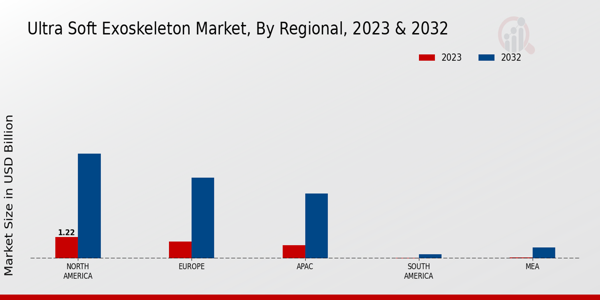Growing Aging Population
The growing aging population worldwide is a significant driver for the Global Ultra Soft Exoskeleton Market Industry. As the demographic shift continues, there is an increasing need for assistive technologies that can help older adults maintain mobility and independence. The market is expected to expand substantially, potentially reaching 30.5 USD Billion by 2035. Countries with high elderly populations, such as Italy and Japan, are particularly focused on integrating ultra-soft exoskeletons into their healthcare systems to address the challenges associated with aging, thereby enhancing the quality of life for seniors.
Market Growth Projections
The Global Ultra Soft Exoskeleton Market Industry is projected to experience substantial growth over the next decade. With a forecasted market size of 3.61 USD Billion in 2024 and an anticipated increase to 30.5 USD Billion by 2035, the industry is set to expand rapidly. This growth is underpinned by a CAGR of 21.39% from 2025 to 2035, reflecting the increasing adoption of ultra-soft exoskeletons across various sectors, including healthcare, industrial, and personal use. The upward trajectory of the market indicates a robust demand for innovative solutions that enhance mobility and support rehabilitation efforts.
Government Initiatives and Funding
Government initiatives and funding aimed at promoting advanced healthcare technologies are playing a crucial role in the Global Ultra Soft Exoskeleton Market Industry. Various countries are investing in research and development to foster innovation in rehabilitation technologies. For instance, the European Union has launched programs to support the integration of soft exoskeletons in healthcare settings. Such initiatives not only enhance the visibility of these technologies but also encourage collaboration between public and private sectors, thereby accelerating market growth and expanding the reach of ultra-soft exoskeletons in rehabilitation and mobility assistance.
Rising Awareness of Workplace Safety
The Global Ultra Soft Exoskeleton Market Industry is also benefiting from a heightened awareness of workplace safety and ergonomics. Industries such as construction and manufacturing are increasingly adopting exoskeletons to reduce the risk of musculoskeletal disorders among workers. By providing support during physically demanding tasks, these devices enhance productivity and worker safety. For example, companies in the United States are implementing ultra-soft exoskeletons to mitigate injury risks, which in turn is expected to drive market growth as organizations recognize the long-term cost benefits associated with improved worker health.
Technological Advancements in Soft Robotics
Technological advancements in soft robotics are significantly propelling the Global Ultra Soft Exoskeleton Market Industry. Innovations in materials science and robotics are leading to the development of lighter, more flexible exoskeletons that can be worn comfortably for extended periods. For instance, the introduction of soft actuators and sensors allows for more intuitive control and better user experience. As these technologies evolve, they are expected to contribute to a compound annual growth rate (CAGR) of 21.39% from 2025 to 2035, indicating a robust future for the industry.
Increasing Demand for Rehabilitation Solutions
The Global Ultra Soft Exoskeleton Market Industry is witnessing a surge in demand for rehabilitation solutions, particularly among the aging population and individuals with mobility impairments. As healthcare systems globally prioritize rehabilitation technologies, the market is projected to reach 3.61 USD Billion in 2024. This growth is driven by advancements in soft robotics, which offer more adaptable and user-friendly solutions for patients. Countries such as Japan and Germany are leading the way in integrating these technologies into rehabilitation programs, enhancing patient outcomes and reducing recovery times.













